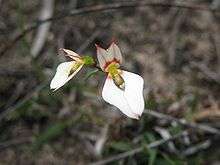Levenhookia pauciflora
Levenhookia pauciflora, the deceptive stylewort, is a dicotyledonous plant that belongs to the genus Levenhookia (family Stylidiaceae). It is an ephemeral annual that grows from 5–10 centimetres (2.0–3.9 in) tall with ovate to suborbicular leaves. Flowers are white and bloom from September to November in its native range. L. pauciflora is endemic to Western Australia where it grows in sandy soils in sandstone or granitic areas.[1][2] The flowers of L. pauciflora resemble those of Stylidium ecorne and it has been said that S. ecorne mimics L. pauciflora to take advantage of its pollinators.[3]
| Levenhookia pauciflora | |
|---|---|
 | |
| Scientific classification | |
| Kingdom: | Plantae |
| Clade: | Tracheophytes |
| Clade: | Angiosperms |
| Clade: | Eudicots |
| Clade: | Asterids |
| Order: | Asterales |
| Family: | Stylidiaceae |
| Genus: | Levenhookia |
| Section: | L. sect. Levenhookia |
| Species: | L. pauciflora |
| Binomial name | |
| Levenhookia pauciflora | |
| Synonyms | |
| |
Taxonomy
The specific epithet pauciflora, referring the Latin term for 'few flowered'.[4][5]
gollark: While we're all made here, I'd like to note that I made *all* the entries.
gollark: -30 seconds remaining.
gollark: Excellent. 30 seconds remaining.
gollark: Your okay has been acknowledged.
gollark: No.
References
- Paczkowska, Grazyna. (1996). Levenhookia pauciflora Benth. FloraBase, Western Australian Herbarium, Department of Environment and Conservation, Government of Western Australia. Accessed online: 23 August 2007.
- Mildbraed, J. (1908). Stylidiaceae. In: Engler, A. Das Pflanzenreich: Regni vegetabilis conspectus. IV. 278. Leipzig.
- Carlquist, S. (1969). Studies in Stylidiaceae: New taxa, field observations, evolutionary tendencies. Aliso, 7(1): 13-64.
- Allen J. Coombes The A to Z of Plant Names: A Quick Reference Guide to 4000 Garden Plants, p. 106, at Google Books
- D. Gledhill The Names of Plants, p. 220, at Google Books
This article is issued from Wikipedia. The text is licensed under Creative Commons - Attribution - Sharealike. Additional terms may apply for the media files.